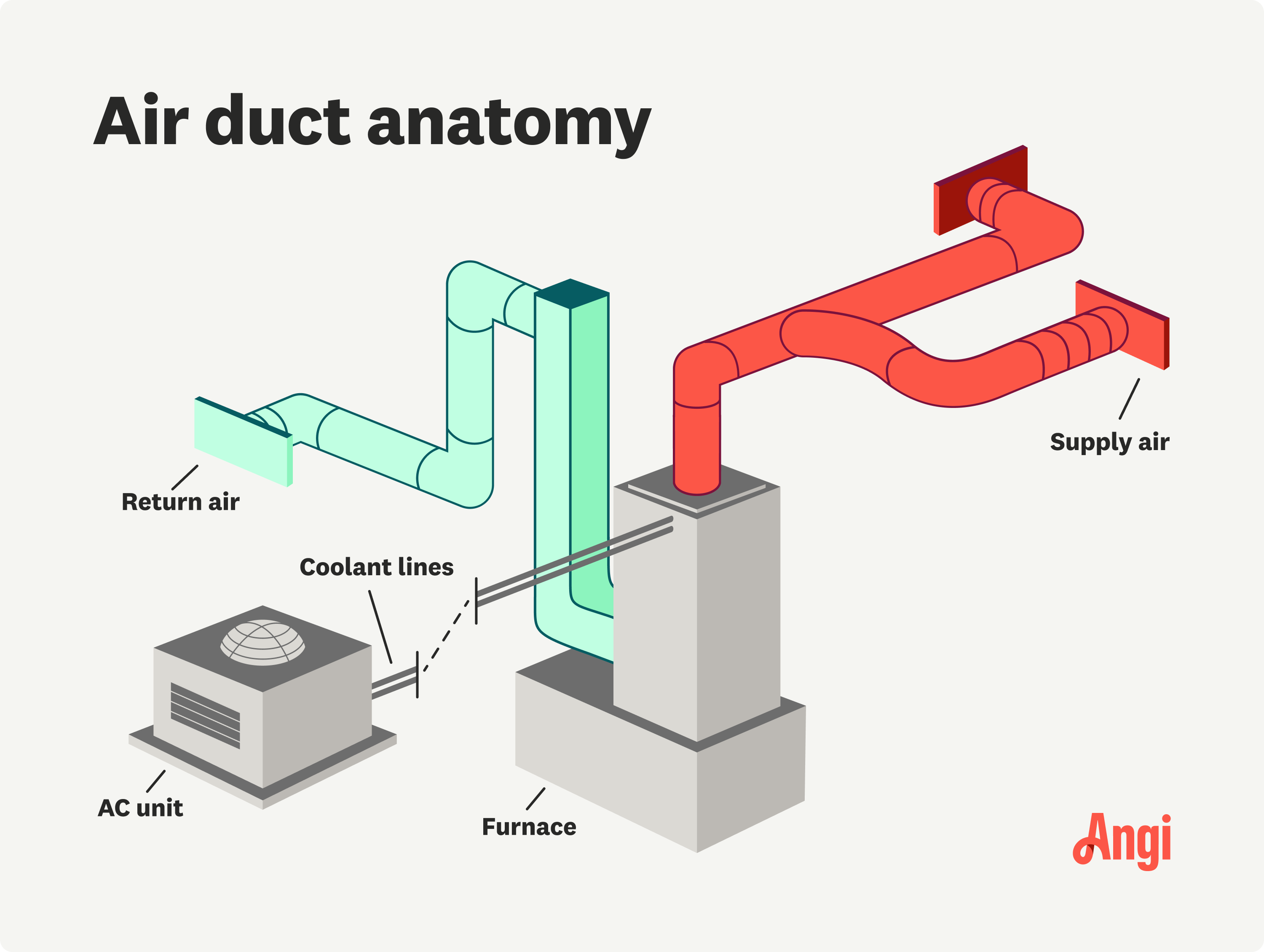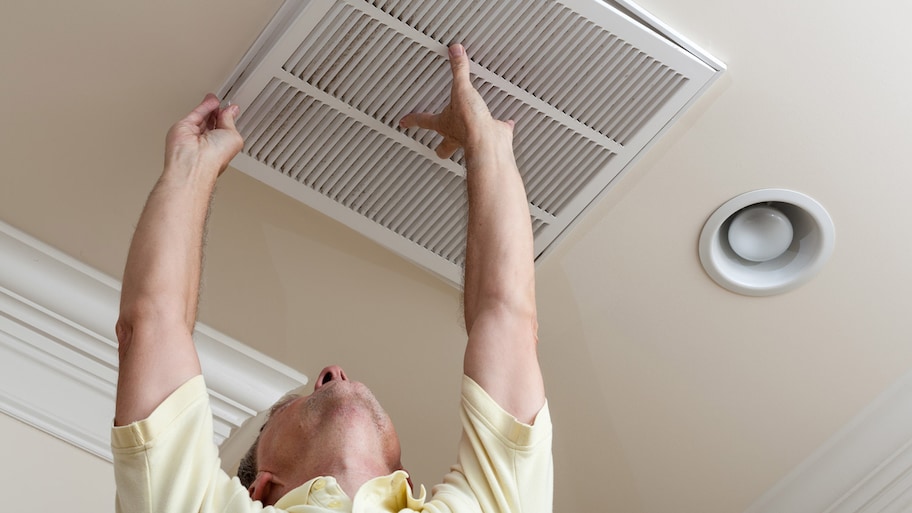What Are Air Ducts? Understanding Your Home’s Ductwork
Breathe easy and get to know the ins and outs of your home's air ducts


Highlights
Your air ducts deliver cool and hot air throughout your home.
There are sheet metal, fiberglass-lined, fiberboard, and flexible ducts.
Some signs you need a cleaning include dirty vents and a pest infestation.
Air duct cleaning costs $380 on average and ranges between $270 to $490.
You may be wondering—what are air ducts? If your home has central air, then your air ducts play an essential role in keeping you cool in the summer and warm in the winter. When you’re enjoying wafts of cool, refreshing air in the summer or warm and cozy indoor temperatures in the winter, you have your air ducts to thank! These ducts connect with your HVAC system and help to facilitate the flow of air throughout your home. Because they can influence your home’s air quality, air ducts must be clean and functional.
What Are Air Ducts and How Do They Work?
Air ducts are responsible for delivering heated or cooled air to different areas in your home. If your home has an HVAC system, then air ducts are responsible for regulating the temperature. The same duct system carries air from both the AC and the furnace. They’re commonly made out of galvanized steel, aluminum, or fiberglass.

Types of Air Ducts
Here are the main types of ducts you can use in your home. Usually, homes have a combination of flexible ducts and sheet metal, fiberglass-lined, or fiberboard ducts.
Sheet Metal Air Ducts
Sheet metal air ducts are durable, non-porous, and easy to customize during installation. Manufacturers commonly make these with galvanized steel, stainless steel, or aluminum. All these metal types are resistant to mold and corrosion, although rust can form without proper maintenance.
These air ducts are also easy to clean, maintain, and repair. They aren't affected by extreme temperature changes and are very durable.
Sheet metal air ducts cost $7 to $13 per linear foot for materials. Additionally, labor costs for installation tend to run higher for sheet metal air ducts than other duct types.
Fiberglass Lined
Fiberglassed-lined air ducts are metal ducts with fiberglass lining, either on the interior or exterior. The fiberglass helps as a sound and thermal insulator. This type of duct costs $7 to $13 per linear foot for materials.
It's important to maintain your fiberglass-lined air ducts properly. Over time, the primary seal on the ducts can wear down from extreme temperature changes. When the seal breaks down, raw fiberglass fibers can enter the airstream.
This is avoidable with preventative maintenance and a regular cleaning schedule. It's possible to repair, replace, or remove the liner as necessary. It’s also a good idea to consider installing a high-efficiency air filtration system if you use fiberglass-lined ducts.
Fiberboard Air Ducts
Manufacturers make fiberboard air ducts from flat sheets of resin-bonded fiberglass. They have an air and vapor barrier on the exterior, and some have an antimicrobial coating on the interior. This option also offers sound and thermal insulation and costs $4 to $6 per linear foot for materials.
Flexible Air Ducts
True to their name, flexible air ducts are easily bendable thanks to a bendable polymer plastic lining with round wire coils inside. HVAC pros commonly use them to branch off the main HVAC system and deliver air to different rooms in the house. Correct installation is key to preventing flexible air ducts from sagging over time.
Insulated flexible air ducts cost $2 to $4 per linear foot for materials, while non-insulated flexible ducts cost $1 to $3 per linear foot.
Signs Your Air Ducts Need Cleaning
Do you remember the last time you got your HVAC ductwork cleaned? Here are some signs it's time to clean your air ducts.
Little or No Air Flow
To check your ducts’ air flow, you can put a piece of paper in front of the vent. All of the vents in your home should have the same amount of air flow.
Another way to know if you have little or no air flow is if you notice different rooms in your house are at different temperatures. Also, you might notice that your home is not heating or cooling as well or as quickly as it used to.
Besides needing a cleaning, it's possible that your HVAC system has leaks. You should call in a pro to get this checked out.
Loud Noises
Although HVAC systems do make noise, you should keep an eye out for anything unusual. Loud noises like rattling and whistling can signal a problem. In addition to a cleaning that’s overdue, you may have damaged ducts or ducts that need to be reconnected or tightened.
Low Indoor Air Quality
It can be hard to know if your indoor air quality is poor, but there are some signs to look out for. If you suffer from dust or mold allergies, you may have noticed symptoms flaring up more than usual.
Poor indoor air quality can also affect your asthma. And in general, you may notice you and your family members coughing or sneezing more often.
Increased Utility Bills
If you’ve noticed your utility bills increasing even though the rates haven’t changed, it could be due to dirty air ducts. When your ducts are dirty, your HVAC system has to work extra hard to cool or heat your home.
Avoid this problem with regular maintenance to keep air ducts clean. After all, it’s much better to put that extra money towards a ductwork cleaning than to give it to the utility companies.
Keep in mind that your increased utility bills may not be due to dirty ducts. Other reasons for this issue include leaks or under-insulated ducts.
Dirty Vent Covers
It's normal for a little bit of debris and dust to collect on your vents. However, if you notice a lot of dust or debris on your vents, it’s likely that there’s a lot of dust in your ductwork.
Additionally, keep an eye out for mold growth around the vent covers, which can signal a mold problem. If you have a keen nose, you're likely to also notice a moldy smell.
Signs of Rodents or Insects
Rodents and insects can take up residence in your air ducts, which can cause a lot of problems.
You may hear strange sounds in your ceilings like running and gnawing (because rodents like to chew on ducts). Or, it might be something more unpleasant like a bad smell. Your allergies may get worse too.
And if you get a chance to look at your ducts, you may notice rips, holes, droppings, cockroach shells, and egg capsules.
Unpleasant Odor
A range of unpleasant odors can signal it’s time for a cleaning. You may notice a musty or moldy smell from the inside your ducts. You may also smell something burning, which is likely the accumulated dust burning off in your ducts as hot air passes through it.
Moreover, if you have a rodent problem, you’ll notice a stinging ammonia smell from their urine. And if you notice a musty, oil-like odor, it could be from cockroach droppings.
Why Air Ducts Benefit From Regular Cleaning
The Environmental Protection Agency only recommends cleaning air ducts if there’s an issue like mold, dust, or rodents. However, some HVAC companies believe that cleaning air ducts more regularly can reduce allergens and improve air quality.
Some things to put on your HVAC maintenance checklist include replacing filters, checking for leaks in the HVAC cabinet, and lubricating motors and bearings. If you don’t want to take on all the detailed work yourself, get in touch with an air duct cleaning company near you to discuss your options.
The frequency of air duct cleaning isn’t an exact science. Experts recommend that you clean your air ducts approximately every two to five years, but where you live, how often you use your HVAC, and whether people in your household have sensitivities can sway this frequency. If you see signs of mold, an unfortunate vermin infestation, or visible dust coming from your air ducts, it’s a good idea to get them cleaned.
How to Spot Signs of Mold in Your Air Ducts
As unpleasant as mold growing in your home is, it’s even more unpleasant to think about your HVAC system spreading it around. If there’s mold in your air ducts, you could be breathing in tiny mold spores without even realizing it. Luckily, mold growing in your air ducts is pretty uncommon. Some tell-tale signs of mold are a musty or mildew smell, visible mold on or near HVAC components, and physical side effects such as nausea, fatigue, runny nose, coughing, and sneezing.
How Much Does Air Duct Cleaning Cost?

Heat and AC ducts cleaning costs about $380 on average, but can range from $275 to $500. This includes the cost of inspecting your HVAC system and cleaning all relevant parts. Hiring a pro for this job is definitely an expense, but many deem air duct cleaning worth the money—especially if they have severe allergies.
Looking for a more affordable DIY solution? Regularly checking and changing the filters in your HVAC system is a more effective way to improve air quality than cleaning your air ducts.
Know When to Replace Your Ductwork
There are a few things to remember when figuring out if you need to replace your ductwork. Most ducts last 10 to 15 years with proper maintenance, so if it’s been longer, you might want to replace them.
In other cases of severe damage, you should replace your ductwork. For example, if your house floods, you may need to replace your ductwork if the water reaches so high that the ducts are completely underwater. If the water didn’t reach your ducts, consider replacing any insulation.
Even if you don’t deal with anything as severe as a flood, you need to take action if you notice mold or mildew growing on your ductwork’s insulation. If an HVAC pro cannot clean it, you may need to replace the ductwork altogether to avoid future mold regrowth.
Margaret Wack contributed to this piece.
